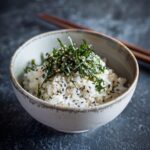Introduction
Wakame Takikomigohan, or seaweed mixed rice, is a delightful and easy-to-make Japanese dish that showcases the simplicity and elegance of Japanese cuisine. This dish combines the delicate flavors of white rice with the umami richness of wakame (seaweed) and the nutty aroma of toasted sesame seeds. I first encountered this dish during a family gathering in Japan, where it was served as a comforting side dish that perfectly complemented a variety of main courses. Its subtle flavors and satisfying texture make it a favorite in my kitchen.


Cultural Context
Takikomigohan, meaning “mixed rice,” is a traditional Japanese dish where rice is cooked with various seasonings and ingredients. This method allows the flavors to meld together, creating a harmonious and flavorful dish. Wakame, a type of seaweed, is commonly used in Japanese cooking for its nutritional benefits and distinct taste. This dish is often enjoyed during family meals and special occasions, highlighting the Japanese emphasis on seasonal and healthy ingredients.
Ingredient Spotlight
White Japanese Rice: Known for its short grains and sticky texture, this rice is ideal for absorbing flavors from the added ingredients.
Wakame (Seaweed): Provides a unique umami flavor and is rich in vitamins and minerals. It adds a slight chewiness to the rice, enhancing the overall texture.
Soy Sauce: Adds a salty, savory depth to the dish.
Sesame Seeds: Toasted black or white sesame seeds contribute a nutty aroma and a slight crunch.
Wakame takikomigohan Health Benefits
Wakame Takikomigohan is a nutritious dish that incorporates several health benefits. Wakame is rich in iodine, calcium, vitamins A, C, E, and K, and omega-3 fatty acids. The sesame seeds provide healthy fats, fiber, and antioxidants. Together with white rice, which offers a good source of energy, this dish is a balanced and wholesome meal.
Cooking Tips
Avoiding Mushy Rice: To prevent the rice from becoming mushy, remove a few tablespoons of water before cooking, as the soy sauce and rehydrated wakame add moisture.
Toasting Sesame Seeds: Toast the sesame seeds on low heat until fragrant to enhance their flavor.
Rehydrating Wakame: Ensure the wakame is fully rehydrated and drained before adding it to the rice to maintain the right texture.
Serving Suggestions
Serve Wakame Takikomigohan as a side dish with grilled fish, miso soup, or a simple vegetable stir-fry. Garnish with freshly ground sesame seeds or gomashio (sesame seeds mixed with a little salt) for added flavor. Pair this dish with a light green


Variations
Different Grains: Substitute white rice with brown rice or mixed grains for a more complex texture and additional nutrients.
Additional Ingredients: Add chopped vegetables like carrots, edamame, or shiitake mushrooms to the rice for extra flavor and color.
Seasonings: Experiment with different seasonings like mirin or sake for a slight variation in taste.
Conclusion
Wakame Takikomigohan is a simple yet deeply satisfying dish that brings the essence of Japanese home cooking to your table. Its combination of delicate flavors and nutritional benefits makes it a versatile addition to any meal. Try this recipe and share your thoughts or any variations you made in the comments below. I’d love to hear about your experiences and suggestions for future recipes! Happy cooking!
PrintWakame Takikomigohan Recipe
A Simple Yet Flavorful Japanese Rice Dish. Wakame Takikomigohan, or seaweed mixed rice, is a delightful and easy-to-make Japanese dish that showcases the simplicity and elegance of Japanese cuisine.
- Cuisine: Japanese
Ingredients
- 2 cups white Japanese rice
- 5 grams dried wakame (seaweed), or about 3/4-1 cups worth rehydrated
- 1 Tbsp soy sauce
- 1–2 Tbsp black sesame seeds, toasted; or white sesame seeds
For serving:
Freshly toasted and ground sesame seeds, or gomashio (sesame seeds mixed with a little salt)
Instructions
- Rehydrate the wakame until nice and plump, drain water.
- Cut wakame into small pieces (I like them around ½ in to ¼ in big)
- Rinse the rice as you usually would (until the water runs clear)
- Place rice into rice cooker and add water to the 2 cup marker. Remove 2 Tbsp of water.
- Add soy sauce, wakame, and sesame seeds and cook!
- Once the rice is cooked gently fold the wakame and sesame seeds into the rice to evenly distribute.








Konnichiwa! (Hello!) I'm Pat Tokuyama, a Japanese tofu cookbook author, who travels for music, food, and adventure. If you like Japanese tea, checkout some of the newestorganic japanese tea, matcha bowls and noren and more!
** Curious about the Plant Based Japanese Cooking Club? ** Learn more here!